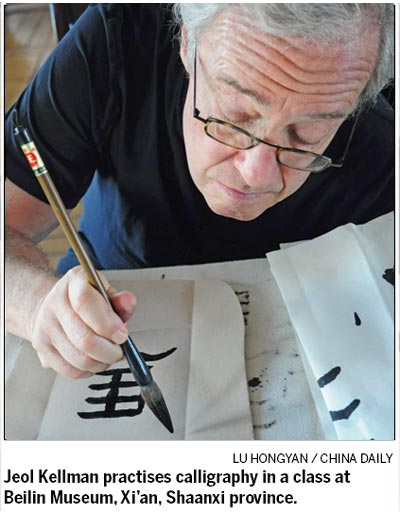
 'Taken 2' grabs movie box office crown
'Taken 2' grabs movie box office crown
 Rihanna's 'Diamonds' tops UK pop chart
Rihanna's 'Diamonds' tops UK pop chart
 Fans get look at vintage Rolling Stones
Fans get look at vintage Rolling Stones
 Celebrities attend Power of Women event
Celebrities attend Power of Women event
 Ang Lee breaks 'every rule' to make unlikely new Life of Pi film
Ang Lee breaks 'every rule' to make unlikely new Life of Pi film
 Rihanna almost thrown out of nightclub
Rihanna almost thrown out of nightclub
 'Dark Knight' wins weekend box office
'Dark Knight' wins weekend box office
 'Total Recall' stars gather in Beverly Hills
'Total Recall' stars gather in Beverly Hills
When in Xi'an, learn Chinese calligraphy
Updated: 2012-07-03 10:52
By Lu Hongyan and Ma Lie in Xi'an (China Daily)
|
||||||||

Acclaimed for its Terracotta Warriors, Xi'an is fast becoming the place to learn Chinese calligraphy.
Since July 2011, more than 300 foreigners have started Chinese calligraphy courses in the city's Beilin Museum, which contains the largest and richest collection of ancient Chinese stone tablets, says Wu Ruchang, the museum's calligrapher.
"More foreigners now like to learn Chinese and they feel proud if they can also write Chinese calligraphy," Wu says.
Most of the students are from the United States including high flyers such as Wall Street bankers, corporation CEOs, financial elites, writers, doctors, lawyers and cultural scholars.
Jeol Kellman, a doctor from the US, has been to China more than 10 times but this is the first time he has enrolled in a Chinese calligraphy class. "I like Chinese culture and calligraphy very much, but I did not know how to write such beautiful words with a soft brush before," Kellman says.
Apart from picking up the skill themselves, some adults also brought their children. The 10-year-old son of the Carter family from Harvard is proud of being able to write a complete Chinese character after an hour of practising.
"I like it very much and I will come back again to learn Chinese calligraphy at the museum when I grow up," the boy says.
According to Wu, many foreigners find the origin of calligraphy and Chinese characters mysterious, and they are fascinated with pictographs such as inscriptions on oracle-bone, ancient bronze objects and seal scripts.
"In the class, I selected some ancient hieroglyphic words to describe the evolution of Chinese characters, to give them a visual impression so that they better understand Chinese characters and Chinese calligraphy," Wu says.
The edu-tourism package is organized by WildChina, a travel company base in Beijing. It was started in 2000 by Zhang Mei, a native of Yunnan province, who holds a Harvard MBA.
"At WildChina, cultural interaction is key to what we do. We encourage people to engage with locals and experience Chinese culture," Zhang says.
"One of our favorite destinations is Xi'an where our visitors get to try their hands at calligraphy."
Located in downtown Xi'an, capital of Shaanxi province, the Beilin (forest of stone tablets) Museum was built in 1087.
With more than 1,000 memorial tablets from the Western Han Dynasty (206 BC-24 AD) to the Qing Dynasty (1644-1911), it is considered a treasure trove of calligraphy and one of the 50 must-visit places in China.
Contact the writers through luhongyan@chinadaily.com.cn.
Most Viewed
Editor's Picks

|

|

|

|

|

|
Today's Top News
Health new priority for quake zone
Xi meets US top military officer
Japan's boats driven out of Diaoyu
China mulls online shopping legislation
Bird flu death toll rises to 22
Putin appoints new ambassador to China
Japanese ships blocked from Diaoyu Islands
Inspired by Guan, more Chinese pick up golf
US Weekly

|

|






